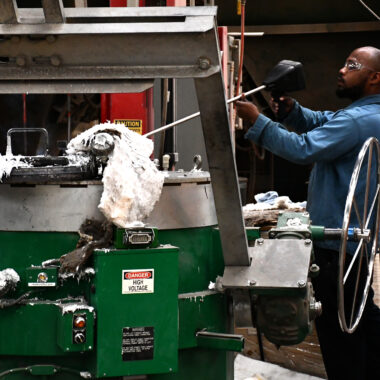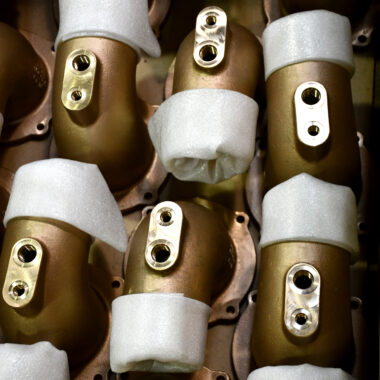About Aluminum Casting Basics: Everything You Need to Know
About Aluminum Casting Basics: Everything You Need to Know
Blog Article
Crafting Excellence: How to Attain High-Quality Light Weight Aluminum Castings Every Single Time
In the world of aluminum spreading, the quest of perfection is a constant trip that calls for a meticulous technique and an eager understanding of the ins and outs included. Accomplishing constant premium light weight aluminum spreadings requires a comprehensive grasp of the procedures, from selecting the ideal alloy to executing exact mold layouts and diligently managing casting parameters. The real proficiency lies in the capability to implement these aspects flawlessly to develop perfect spreadings every time. As we discover the ins and outs of crafting excellence in aluminum spreadings, revealing the key strategies and techniques that bring about impressive results ends up being paramount for those striving for excellence in this specific area.
Understanding Light Weight Aluminum Casting Processes
Aluminum casting procedures, important in the manufacturing sector, include the detailed change of molten light weight aluminum into strong types through a collection of very carefully regulated steps. Understanding these processes is critical to attaining top quality light weight aluminum spreadings constantly - about aluminum casting. The main approaches used in aluminum spreading are die casting, sand spreading, and financial investment spreading

Each of these processes has its benefits and is selected based on aspects like intricacy, volume, and wanted coating of the light weight aluminum spreading. about aluminum casting. Comprehending the details of these approaches is vital for producers intending to generate top notch aluminum castings consistently
Choosing the Right Aluminum Alloy
Picking the ideal aluminum alloy is a crucial choice in the production of high-grade aluminum spreadings. When selecting a light weight aluminum alloy for casting, it is crucial to think about the particular needs of the application to ensure ideal efficiency.
Among one of the most generally utilized light weight aluminum alloys for spreading is A356. This alloy offers outstanding castability, high stamina, and great deterioration resistance, making it suitable for a variety of applications. 6061 aluminum alloy is preferred for its remarkable weldability and great mechanical properties. For applications needing high stamina, 7075 light weight aluminum alloy is a popular selection because of its exceptional strength-to-weight proportion.
Along with mechanical More Help homes, factors to consider such as price, availability, and post-casting processes should also influence the selection of the ideal light weight aluminum alloy. By meticulously evaluating these factors, suppliers can guarantee the production of premium light weight aluminum castings that satisfy the preferred specs.
Carrying Out Appropriate Mold Layout
Developing an effective mold and mildew style is important for guaranteeing the effective production of high-quality light weight aluminum spreadings. Proper mold design plays a significant duty in accomplishing the desired attributes of the end product. To implement an effective mold and mildew layout, factors such as material circulation, cooling down prices, and component geometry should be thoroughly considered.
One trick facet of mold layout is making sure proper dental filling and solidification of the aluminum within the mold and mildew tooth cavity. This involves creating runner and gating systems that help with smooth steel flow and avoid issues such as air entrapment or incomplete filling. In addition, incorporating air conditioning channels right into the mold layout assists regulate solidification rates and minimize the threat of porosity or shrinkage flaws.

Controlling Spreading Parameters

Ensuring Post-Casting Top Quality Checks
To keep the high quality of aluminum castings, thorough post-casting top quality checks are crucial. After the spreading procedure is completed, it is vital to make certain that the final products fulfill the wanted specifications and requirements.
Dimensional accuracy is one more essential facet that must be verified throughout post-casting top quality checks. Measurements of vital dimensions and tolerances need to be taken to validate that the spreadings conform to the required specifications. In addition, mechanical residential properties such wikipedia reference as firmness, tensile stamina, and effect resistance may need to be assessed with material testing to ensure that the castings have the needed my website stamina and toughness for their designated application.
Final Thought
In final thought, accomplishing top notch aluminum spreadings requires a thorough understanding of the spreading procedures, picking the ideal alloy, designing molds effectively, controlling spreading parameters meticulously, and performing post-casting high quality checks vigilantly. By following these actions, makers can regularly produce light weight aluminum castings that meet the greatest criteria of top quality and efficiency.
Attaining regular top notch light weight aluminum spreadings requires a thorough grasp of the processes, from choosing the appropriate alloy to carrying out exact mold styles and carefully regulating casting specifications. The main approaches utilized in light weight aluminum casting are pass away casting, sand spreading, and investment casting.
Financial investment spreading, additionally understood as accuracy casting, includes developing wax patterns that are covered in ceramic to develop mold and mildews.Selecting the proper aluminum alloy is an essential decision in the manufacturing of high-quality aluminum spreadings.Ensuring accurate control over casting criteria is necessary for keeping consistency and high quality in light weight aluminum casting manufacturing.
Report this page